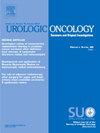单孔和多孔腹膜后机器人肾部分切除术的疗效比较。
IF 2.3
3区 医学
Q3 ONCOLOGY
Urologic Oncology-seminars and Original Investigations
Pub Date : 2024-10-08
DOI:10.1016/j.urolonc.2024.09.017
引用次数: 0
摘要
简介单孔(SP)机器人手术系统在狭小的解剖空间内表现良好,因此适用于腹膜后机器人肾部分切除术(RPN)。然而,将 SP RPN 与多孔 (MP) RPN 的安全性和可行性进行比较的证据有限。为了填补这一证据空白,我们试图分析和比较SP和MP两种腹膜后RPN方法的安全性:这是一项回顾性队列研究,使用的数据来自单孔先进研究联盟(SPARC)和一个多中心数据库,该数据库收录了 2017 年至 2023 年间使用 SP 或 MP 进行腹膜后 RPN 手术的患者。基线、围术期和术后数据的比较采用t检验、Mann-Whitney U检验、χ2检验和Fisher精确检验。使用稳健回归和泊松回归进行多变量分析:共有 286 名患者(SP RPN,n = 86 [30%];MP RPN,n = 200 [70%])接受了腹膜后 RPN。两组患者的R.E.N.A.L肾功能评分和肿瘤位置有显著差异。值得注意的是,MP 组的缺血时间明显更短(16 分钟对 SP,22 分钟,P < 0.001)。调整基线特征后,SP 组患者的缺血时间比 MP 组平均长约 7.89 分钟(95% CI:5.87, 9.92;P <0.001)。两组患者在手术时间、EBL、输血、转换率、LOS、PSM和术后30天总体并发症方面无明显差异:我们的研究表明,腹膜后 SP 和 MP RPN 的围手术期和术后效果相当,只是 SP 平台的缺血时间较长。腹膜后 SP RPN 是一种安全可行的替代方法,但仍需进一步研究其潜在优势、成本效益和长期肿瘤治疗效果。本文章由计算机程序翻译,如有差异,请以英文原文为准。
Comparison of outcomes between single-port and multiport retroperitoneal robotic partial nephrectomy
Introduction
Single-port (SP) robotic surgical system performs well in small anatomical spaces, which makes it suitable for retroperitoneal robotic partial nephrectomy (RPN). However, there is limited evidence comparing the safety and feasibility of SP RPN to multiport (MP) RPN. To address this gap in evidence, we sought to analyze and compare the safety of retroperitoneal RPN between SP and MP approaches.
Methods
This is a retrospective cohort study using data from the Single Port Advanced Research Consortium (SPARC) and a multicenter database of patients who underwent retroperitoneal RPN using either SP or MP between 2017 and 2023. Baseline, perioperative, and postoperative data were compared using t-tests, Mann-Whitney U test, χ2 test, and Fisher exact test. Multivariable analyses were conducted using robust and Poisson regressions.
Results
A total of 286 patients (SP RPN, n = 86 [30%]; MP RPN, n = 200 [70%]) underwent retroperitoneal RPN. R.E.N.A.L nephrometry score and tumor location were significantly different between the 2 groups. Notably, the ischemia time was significantly shorter in the MP group (16 vs. SP, 22 minutes, P < 0.001). Adjusting for baseline characteristics, the ischemia time was approximately 7.89 minutes longer for patients in the SP group compared to the MP group, on average (95% CI: 5.87, 9.92; P < 0.001). No significant differences were observed in operative time, EBL, blood transfusion, conversion rates, LOS, PSM, and overall 30-day postoperative complications between the 2 groups.
Conclusion
Our study shows that retroperitoneal SP and MP RPN have comparable perioperative and postoperative outcomes, except for the longer ischemia time in the SP platform. SP RPN is a safe and viable alternative; however, further research is needed to explore its potential benefits, cost-effectiveness, and long-term oncologic outcomes.
求助全文
通过发布文献求助,成功后即可免费获取论文全文。
去求助
来源期刊
CiteScore
4.80
自引率
3.70%
发文量
297
审稿时长
7.6 weeks
期刊介绍:
Urologic Oncology: Seminars and Original Investigations is the official journal of the Society of Urologic Oncology. The journal publishes practical, timely, and relevant clinical and basic science research articles which address any aspect of urologic oncology. Each issue comprises original research, news and topics, survey articles providing short commentaries on other important articles in the urologic oncology literature, and reviews including an in-depth Seminar examining a specific clinical dilemma. The journal periodically publishes supplement issues devoted to areas of current interest to the urologic oncology community. Articles published are of interest to researchers and the clinicians involved in the practice of urologic oncology including urologists, oncologists, and radiologists.

 求助内容:
求助内容: 应助结果提醒方式:
应助结果提醒方式:


